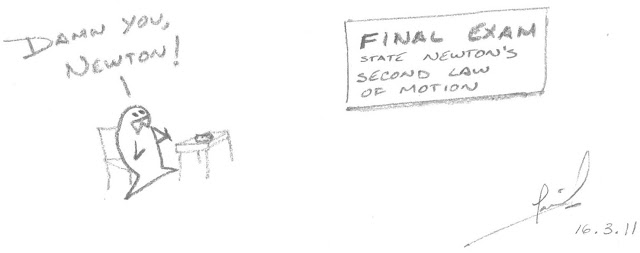 |
| Usual scene in a high-school Physics Exam |
I no longer take Physics tests, so I have all the time in the world to try to explain this concept applied in a real bureaucratic ecosystem. Let's take a look!
We learned earlier that a thing will stay unchanged if it is left alone, right? But if it isn't?? Newton's Second Law states exactly that, which translated to XXI Century English means something like this:
The more force you use to move something, the more it will move. The heavier that thing is, the more difficult it is to move it.
Just that simple! Let's go back to the office example. Let's assume that having the boss walking in is more powerful than the 15:00 hrs lunch time alarm. So, the event of having the boss walking into the office and barking several instructions at the employee, will make him stop procrastinating instantly and will immediately start working on his boss's new assignments. However, if the alarm goes off, before getting up, the employee will perhaps yawn, think on what will he have for dessert and what will he do upon his return, before even turning off the alarm!
 |
| Relationship between Force and Acceleration: Large Force = Fast Action |
 |
| Another example of the relationship between Force and Acceleration: Low Force = Slow Action |
That's the first part of this law, which describes the change from the state of not moving to moving, which is proportional to the force causing this change.
The other part of Newton's Second Law states that heavier things are more difficult to move. By heavier I don't necessarily mean with more mass, but for our example it could also be more prone to procrastinate, having your mind elsewhere or just being sleepy. For instance, if the office employee of our example, missed last night's sleep, because he was hangover, his son was sick or a mosquito just didn't let him, the fact that his boss stepped in and issued a bunch of orders to be followed immediately, will be dismissed and maybe could make it to the to-do list, if lucky...
 |
| Relationship among all three variables: Force, Mass and Acceleration |
So let's say that heavier means prone to inactivity.
Therefore, we can see that acceleration (time to action) is directly proportional to the Force applied (stimuli which causes action) and inversely proportional to the mass (or heaviness; tendency to be inactive). Heck, even Newton had a formula for that!
F = ma
In conclusion, all of us are willing to take action if the stimuli for it is considered worthy. Very subjective stuff we're dealing with, but that is what defines our inertia, in some kind of way.
Newton's Laws of motion for the Real World:
First
Third

Newton's second law can be expressed as
ReplyDeleteF = (d / dt) (mv)
if we take into account the work of Lorentz and consider the change of mass according to his transformation's group.
Then:
F = m (dv / dt) + (dm / dt) v = ma + (dm / dt) v
With this, we see that an employee working very hard (in a given time) may be having a negative mass change (the approach of 6 o’clock syndrome or he is starting to get tired) and so, he is diminishing in productivity.
And, conversely, an employee suffering a hangover may, indeed, have a positive mass change (two Alka Seltzer's) and start working productively.
Physics is the way to go!